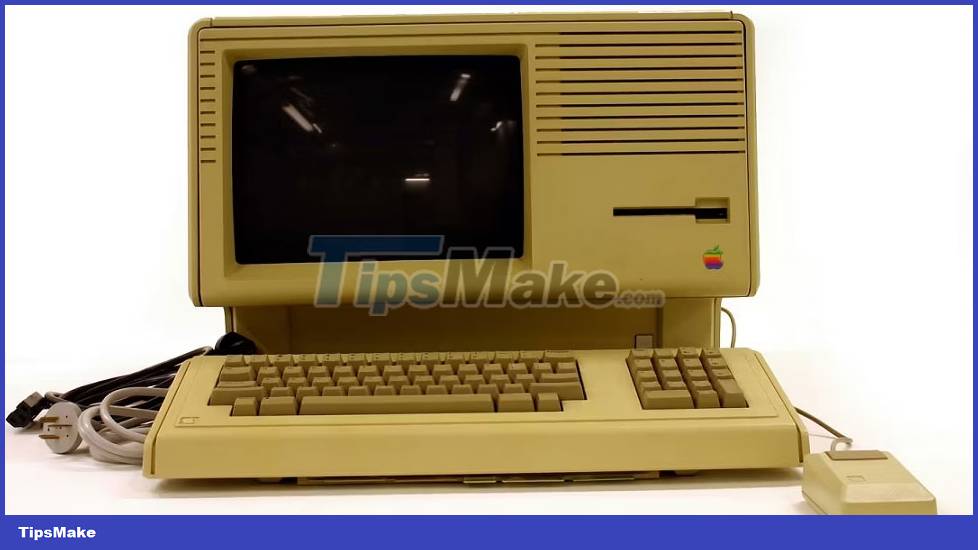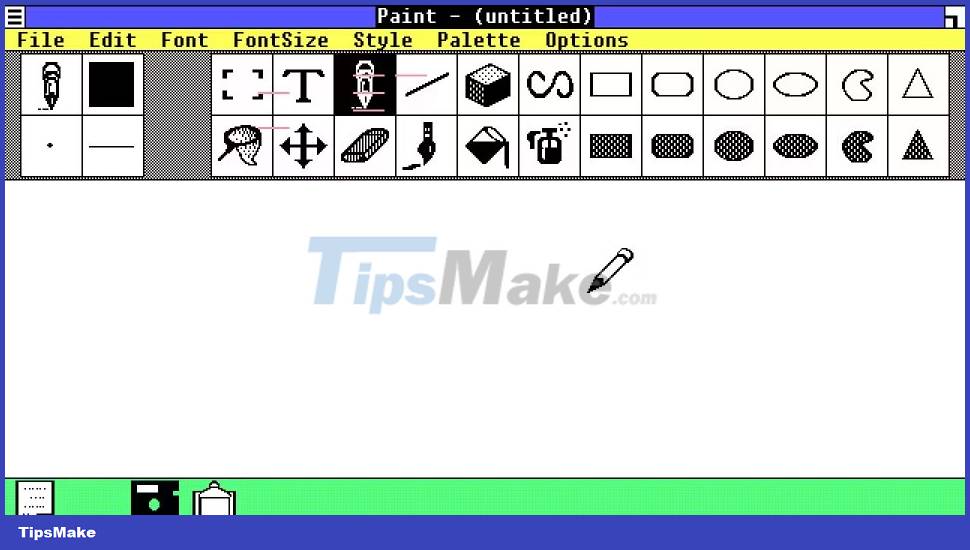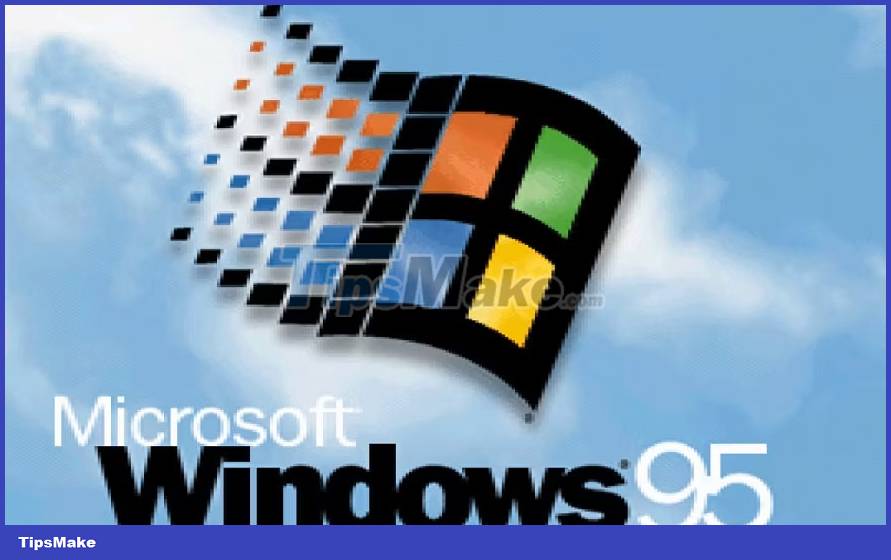The Windows 1.0 operating system is 40 years old
Microsoft revealed Windows 1.0 in November 1983. Since then, Windows still dominates the desktop computer market to this day. Let's look back at Microsoft's historic announcement about Windows 1.0 after 40 years in the following article!
Apple released the Lisa in early 1983
In the early 1980s, computer operating systems were command-based operating systems used by entering text commands. However, a GUI (graphical user interface) revolution is taking place in the IT industry. Apple took a leading position in that revolution when it launched the Lisa in early 1983. It was one of the first PCs with a graphical user interface, allowing users to open programs and files using mouse.
However, the problem with the Apple Lisa is that it's a bit too revolutionary. It was a computer that was a bit ahead of its time with very high specs for an early 1980s PC. This made the Lisa extremely expensive, with a starting price of approximately $10,000. Most users prefer to stick with the slightly cheaper IBM PC.

Microsoft launches Windows 1.0 at COMDEX
However, Lisa still caught the attention of many people in the IT industry with its revolutionary graphical operating system (the predecessor of Macintosh). In response to Lisa (and Visi on the graphical operating system), Microsoft started a GUI operating system project codenamed Interface Manager. Bill Gates announced the development of Windows 1.0 at the Plaza Hotel in New York on November 10, 1983.
When Microsoft announced Windows 1.0, the company said it was a window manager extension of MS-DOS. Microsoft expected Windows 1.0 to expand the MS-DOS software development environment by allowing developers to release more graphically oriented programs. Therefore, the first Windows operating system was more of a complement to MS-DOS than a replacement.
Microsoft demonstrated the first Windows 1.0 pre-release at COMDEX (computer trade show) in November 1983. The world first saw the Windows operating system on a green screen 40 years ago. The first Windows platform allowed users to access multiple running programs by clicking their icons on a bar, much like today's taskbar.
Windows 1.0 also came with a number of applications that today's users are familiar with. Notepad, Paint, and Calc (Calculator) are three programs that came with Windows 1.0 and have remained part of the operating system family ever since. Users can also select the Writer (word processor), Clock, Reversi (board game), Clipboard and Calendar programs from the MS-DOS Executive shell.

You can see what Windows 1.0 looked like on this IBM PC emulator page. Click Full Screen to maximize that emulator's window. Try launching some programs from MS-DOS Executive and minimizing them to the program bar by double-clicking their window title bar. You can switch between programs by clicking their icons in the bar, just like on the current Windows platform.

The Windows revolution began… in 1995
Microsoft delayed the release of Windows 1.0 with a number of additional modifications and improvements. The history of Windows began when the first public version of Windows 1.0 appeared in November 1985, two years after Microsoft announced it. Microsoft launched Windows 1.0 in the US at an affordable price of 99 USD.
Users were really not impressed by Windows 1.0 when experiencing it firsthand. The original Windows operating system had some performance and software compatibility issues. Many people at that time considered Windows 1.0 a failure. So most users preferred to stick with MS-DOS commands throughout the remainder of the 1980s.
PCs of the 1980s were not quite ready for GUI operating systems. The much heavier system demands of a graphical operating system made performance issues inevitable with the limited hardware of the time. PC hardware took about 7 to 10 years to develop before the Windows revolution really began in 1995.

Windows finally hit the big time in 1995. Adding an official Start menu and taskbar to Windows 95 made all the difference. So PCs in the mid-1990s were also much better equipped to handle GUI platforms. After that, the Windows family of operating systems dominated the desktop computer market and the world switched to MS-DOS.
You should read it
- History of Microsoft Windows operating system throughout the ages
- 11 strange 'phenomena' of Windows
- Microsoft provides documents using Windows 8.1
- The chart for the 10 most amazing versions of Windows
- The life cycle of Windows 7 is shorter than Windows XP
- Windows operating system is 35 years old, everything you need to know about Windows
- Windows Blue is being tested internally
- Microsoft's decision to turn Windows 10 S into a mode instead of an ordinary OS version
May be interested
- Windows 7 overcomes Windows XP
 the media said that last august, windows 7 has surpassed the windows xp predecessor to become the most popular operating system on desktop computers.
the media said that last august, windows 7 has surpassed the windows xp predecessor to become the most popular operating system on desktop computers. - How to Revert to the Classic Taskbar on Windows 7
 if you've been used to windows operating systems for years prior to windows 7, you've probably noticed a huge difference with regard to the operating system's visual style. the fonts are sharper, the windows are transparent; however, the...
if you've been used to windows operating systems for years prior to windows 7, you've probably noticed a huge difference with regard to the operating system's visual style. the fonts are sharper, the windows are transparent; however, the... - Microsoft won't (can't) turn Windows 12 into a paid operating system
 a few months ago, a leaked report unexpectedly revealed microsoft's plan to return to the cycle of providing a major windows version every three years, meaning windows 12 could be released as soon as january 1, 2020. next 2 years.
a few months ago, a leaked report unexpectedly revealed microsoft's plan to return to the cycle of providing a major windows version every three years, meaning windows 12 could be released as soon as january 1, 2020. next 2 years. - Windows XP is still the most popular operating system
 according to the latest results of web analytics firm net applications, microsoft's '10-year-old' operating system is still the world's most popular pc platform, although windows 7 is gradually closing the gap. with before.
according to the latest results of web analytics firm net applications, microsoft's '10-year-old' operating system is still the world's most popular pc platform, although windows 7 is gradually closing the gap. with before. - Should I install or upgrade the operating system?
 normally when installing windows operating system, we have two options: install completely new or upgrade. most computer experts recommend that you choose a completely new installation because the new installation will make the operating system much more stable than upgrading, while avoiding potential problems.
normally when installing windows operating system, we have two options: install completely new or upgrade. most computer experts recommend that you choose a completely new installation because the new installation will make the operating system much more stable than upgrading, while avoiding potential problems. - Discovered secrets lurking in Windows 95 over the past 25 years
 there is a mystery that the windows 95 developers have been hiding in an application of this operating system and for more than 25 years no one has discovered.
there is a mystery that the windows 95 developers have been hiding in an application of this operating system and for more than 25 years no one has discovered. - You will get 2 more years of updates on Windows 7 if you buy a new update package of this operating system version
 in its latest announcement, microsoft confirmed it will continue to support windows 7 for another two years but on one condition that users must pay to purchase a customized update package.
in its latest announcement, microsoft confirmed it will continue to support windows 7 for another two years but on one condition that users must pay to purchase a customized update package. - Windows 7 accounts for 99% of business computers
 in a recent interview with zdnet, toshiba group's product marketing manager, cindy zwerling, said that windows 7 is clearly the operating system of the business at this time.
in a recent interview with zdnet, toshiba group's product marketing manager, cindy zwerling, said that windows 7 is clearly the operating system of the business at this time. - Windows 8 was sold before the launch date
 walmart retail system in the us has sold windows 8 models nearly two weeks before the time the operating system was officially released.
walmart retail system in the us has sold windows 8 models nearly two weeks before the time the operating system was officially released. - The Chinese military will replace Windows with its own self-developed operating system
 the chinese military decided to develop its own operating system with the ability to block all cyber attacks from hakders that had contact with the us government over fears that us intelligence agencies could invade. enter any platform.
the chinese military decided to develop its own operating system with the ability to block all cyber attacks from hakders that had contact with the us government over fears that us intelligence agencies could invade. enter any platform.










 Microsoft launches the .NET 8 developer platform with .NET Aspire
Microsoft launches the .NET 8 developer platform with .NET Aspire Warning: Do not download the Google Bard app! It's malware!
Warning: Do not download the Google Bard app! It's malware! How to use AI Image Editor to edit photos with AI
How to use AI Image Editor to edit photos with AI The 12-inch screen can stretch like a piece of LG rubber
The 12-inch screen can stretch like a piece of LG rubber Difference between Flutter and Java
Difference between Flutter and Java How to listen to articles in Safari on iPhone/iPad
How to listen to articles in Safari on iPhone/iPad